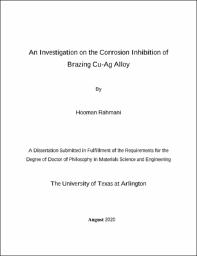
ATTENTION: The works hosted here are being migrated to a new repository that will consolidate resources, improve discoverability, and better show UTA's research impact on the global community. We will update authors as the migration progresses. Please see MavMatrix for more information.
Show simple item record
| dc.contributor.advisor | Yum, Kyungsuk | |
| dc.creator | Rahmani, Hooman | |
| dc.date.accessioned | 2020-09-10T17:43:27Z | |
| dc.date.available | 2020-09-10T17:43:27Z | |
| dc.date.created | 2020-08 | |
| dc.date.issued | 2020-08-25 | |
| dc.date.submitted | August 2020 | |
| dc.identifier.uri | http://hdl.handle.net/10106/29419 | |
| dc.description.abstract | Adsorption and inhibition behavior of 1,2,3-benzotriazole (BTA) and 2,5-dimercapto-1,3,4-thiadiazole (DMTD) on brazing Cu-Ag alloy was studied in deionized water using corrosion potential measurement, potentiodynamic polarization, adsorption isotherm investigation, X-ray photoelectron spectroscopy (XPS), and electrochemical impedance spectroscopy (EIS). Pure Ag and pure Cu specimens were included to investigate the mere effect each component has on the alloy’s behavior along with a high copper alloy for comparison purposes. The electrochemical responses show that BTA shifts the corrosion potential of Cu to the noble direction but has the opposite effect for Ag and a mixed behavior for the Cu-Ag alloys. However, DMTD in all cases shifts the corrosion potentials to the active region for the metals studied. The inhibition efficiency (η) of BTA for Cu and high Cu alloy reached around 95% through chemisorption. Nonetheless, η was significantly lower for Ag and the brazing Cu-Ag alloy having a partially chemisorbed-partially physiosorbed behavior while interacting with BTA. Results show the better inhibition of DMTD for Ag and the brazing Cu-Ag alloy by merely chemisorption. BTA was found to follow Langmuir isotherm while DMTD obeyed Temkin adsorption isotherm, despite both acting as a mixed type inhibitor. Combining the two inhibitors increased the inhibition efficiency over 80% for the Cu-Ag alloy.
XPS results showed the formation of Cu- and Ag-BTA organometallic complexes through the N tail of the inhibitor. In addition, formation of DMTD organometallic film was confirmed through DMTD’s functional groups of pyrrolic N from the azole ring and thiol S from the mercapto anchoring group on Ag and thiol S on Cu. The lower inhibition efficiency of Ag and brazing alloy was attributed to the weak adsorption of BTA on the Ag phase leading to lower corrosion protection of Ag. The higher affinity of DMTD to Ag was attributed to the involvement of two heteroatoms with the Ag surface.
Furthermore, electrochemical impedance spectroscopy (EIS) was utilized to delve into the corrosion inhibition of eutectic Cu-Ag alloy and its components (Cu and Ag) in aqueous, aerated 0.1 M KNO3 solutions. The corrosion inhibition slowly evolved over time as diagnosed by an increase in the charge transfer impedance and the gradual tendency of the Nyquist profiles to arc toward the real axis. This trend was attributed to the gradual formation of organometallic passivation layers replacing the interfacial water molecules on the metal surfaces. The EIS data underlined the specific affinity of BTA and DMTD toward the Cu and Ag surfaces, respectively. A transition of the double layer equivalent circuit element from ideal capacitance to a constant phase element was observed for the alloy compared to the pure metals. This was attributed to the heterogeneity induced by Cu-rich and Ag-rich phases in the alloy and by the formed oxides/protective film on the alloy surface. | |
| dc.format.mimetype | application/pdf | |
| dc.subject | Copper silver alloy | |
| dc.subject | Corrosion | |
| dc.subject | Brazing | |
| dc.subject | Inhibition | |
| dc.subject | Benzotriazole | |
| dc.subject | Thiadiazole | |
| dc.title | An Investigation on the Corrosion Inhibition of Brazing Cu-Ag Alloy | |
| dc.type | Thesis | |
| dc.degree.department | Materials Science and Engineering | |
| dc.degree.name | Doctor of Philosophy in Materials Science and Engineering | |
| dc.date.updated | 2020-09-10T17:43:27Z | |
| thesis.degree.department | Materials Science and Engineering | |
| thesis.degree.grantor | The University of Texas at Arlington | |
| thesis.degree.level | Doctoral | |
| thesis.degree.name | Doctor of Philosophy in Materials Science and Engineering | |
| dc.type.material | text | |
Files in this item
- Name:
- RAHMANI-DISSERTATION-2020.pdf
- Size:
- 5.624Mb
- Format:
- PDF
This item appears in the following Collection(s)
Show simple item record


